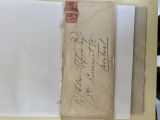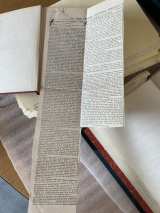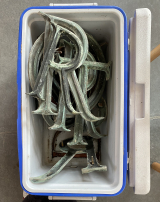By the time I began my third year, I had enjoyed researching the histories of twentieth-century China and Chinese North America. The work of my mentors at the Chinese Historical Society of Southern California always maintained the simple adage that history is messy, complex, and that it takes incredible care to reassemble evidence and represent it as a coherent narrative. We know this well; but taking the adage seriously diverted me from given explanations and towards a morass––which I figured would stay as such but may clarify how we have ended up where we are and how we may transform our social conditions into better ones. That fall, I rearranged my course schedule to accommodate growing research interests in settler colonialism and critical perspectives on empire.

This leads us to my initial draw to the ‘History of Stuff’ internship at Reford Gardens. I hoped to delve further into the history of the Scottish and Irish settlers that resided in the ‘Golden Square’ postal code through Elsie and her husband, Robert Reford’s stuff. It is difficult to capture the Reford Gardens in a brief description. Ever since Alexander Reford––historian and great-grandson of Elsie Reford––helped facilitate the purchase of the gardens from the Québec government in 1995, Elsie’s historic estate has become an energetic cultural hub under his stewardship. This summer, I’ve worked remotely and on site where I dug through the Les Amis de Jardins des Métis collection and produced short descriptions of objects for a complementary exhibition to the recent publication of Elsie Reford: 150 Objects of Passion. The diverse collection and flexible design of my job allowed me to cover a wide breadth of niches: the history of industry, labour, and capital; women and imperialism; certain currents in the social history of the class monikered as the ‘Anglo-protestant bourgeoisie’; the dissemination of news about international relations; Chinese Canadians; and even, gardens and posthumanism.

Historians are as good as their sources. This is what leads one to find and, in Alexander’s case, found alternative archives [‘alternative’ relative to the national archives] and thinking what history could be with different storage and evidence. I welcomed the chance to work through the openings and limitations for writing history through Elsie’s biography on the basis that it would mean I could finally work in one place for long enough to develop some intuitive sense of its organization. The Gardens stuns by its atmosphere – work was made lighter and more thoughtful by its team and majestic environment. I was fortunate enough to work closely with the

An internship is incomplete without its challenges. I had anticipated I’d work with more material rather than textual objects, but the inverse was the case. My two main limitations were expertise in the case of archaeological findings and availability––as in, I had to cover objects not already included in the book. One solution I found was to begin exploring textual documents that could lead me to another object in the collection. When working with archives, we have to get creative; it is a matter of finding our ways around the blunders we encounter.

Last and most important: my greatest gratitude belongs to the St. Andrew’s Society of Montreal and the McEuen Scholarship Foundation for funding this internship and my living expenses this summer. Thank you for making this possible for myself this summer, and for many more students in the past and to come.

